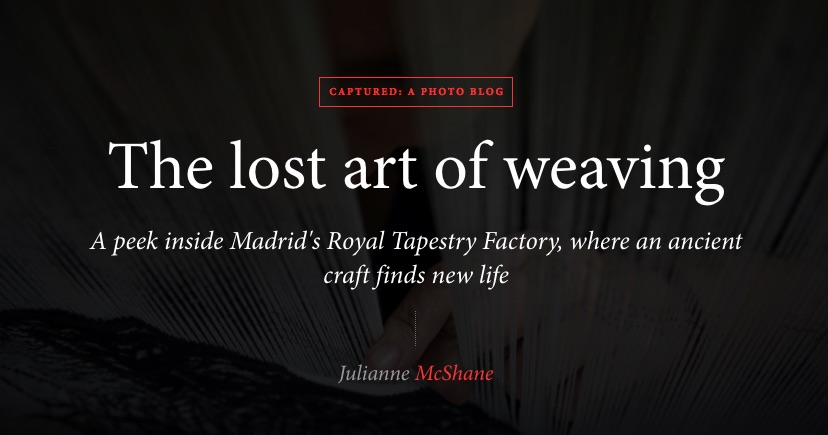
Madrid’s Royal Tapestry Factory is an institution. In its nearly 300-year history, its workers have laboriously hand-woven some of the world’s most coveted tapestries and rugs. Its list of clients includes Spanish royalty, the Four Seasons Hotel George V in Paris, and the Dresden Castle in Germany, to name a few. Celebrated Spanish artist Francisco Goya even got his start at the factory in 1775, staying on for two decades.
Unfortunately, a rich history doesn’t guarantee a prosperous future. The factory has suffered several periods of financial strife and in 2015 nearly closed for good. With the factory teetering on the brink of bankruptcy, its weavers, most of whom started when they were teenagers and are now well into their 50s, went without pay for months. “We keep coming despite the extreme situation because we like our trade,” Rosario Cañete and Veridiana Cabas told the Spanish newspaper
El País in July 2015.
But thanks to a massive order (32 tapestries, the factory’s largest commission in two centuries) and an increase in subsidies from the Spanish government, Royal Tapestry can stay open and its dedicated workers can stay to weave another day. “I was told this industry wouldn’t last beyond tomorrow,” weaver Jose Antonio Carbajal told
Reuters. “It’s been 43 years and I’m still here.”
Source: https://theweek.com/captured/668535/lost-art-weaving
 Madrid’s Royal Tapestry Factory is an institution. In its nearly 300-year history, its workers have laboriously hand-woven some of the world’s most coveted tapestries and rugs. Its list of clients includes Spanish royalty, the Four Seasons Hotel George V in Paris, and the Dresden Castle in Germany, to name a few. Celebrated Spanish artist Francisco Goya even got his start at the factory in 1775, staying on for two decades.
Unfortunately, a rich history doesn’t guarantee a prosperous future. The factory has suffered several periods of financial strife and in 2015 nearly closed for good. With the factory teetering on the brink of bankruptcy, its weavers, most of whom started when they were teenagers and are now well into their 50s, went without pay for months. “We keep coming despite the extreme situation because we like our trade,” Rosario Cañete and Veridiana Cabas told the Spanish newspaper El País in July 2015.
But thanks to a massive order (32 tapestries, the factory’s largest commission in two centuries) and an increase in subsidies from the Spanish government, Royal Tapestry can stay open and its dedicated workers can stay to weave another day. “I was told this industry wouldn’t last beyond tomorrow,” weaver Jose Antonio Carbajal told Reuters. “It’s been 43 years and I’m still here.”
Source: https://theweek.com/captured/668535/lost-art-weaving
Madrid’s Royal Tapestry Factory is an institution. In its nearly 300-year history, its workers have laboriously hand-woven some of the world’s most coveted tapestries and rugs. Its list of clients includes Spanish royalty, the Four Seasons Hotel George V in Paris, and the Dresden Castle in Germany, to name a few. Celebrated Spanish artist Francisco Goya even got his start at the factory in 1775, staying on for two decades.
Unfortunately, a rich history doesn’t guarantee a prosperous future. The factory has suffered several periods of financial strife and in 2015 nearly closed for good. With the factory teetering on the brink of bankruptcy, its weavers, most of whom started when they were teenagers and are now well into their 50s, went without pay for months. “We keep coming despite the extreme situation because we like our trade,” Rosario Cañete and Veridiana Cabas told the Spanish newspaper El País in July 2015.
But thanks to a massive order (32 tapestries, the factory’s largest commission in two centuries) and an increase in subsidies from the Spanish government, Royal Tapestry can stay open and its dedicated workers can stay to weave another day. “I was told this industry wouldn’t last beyond tomorrow,” weaver Jose Antonio Carbajal told Reuters. “It’s been 43 years and I’m still here.”
Source: https://theweek.com/captured/668535/lost-art-weaving
